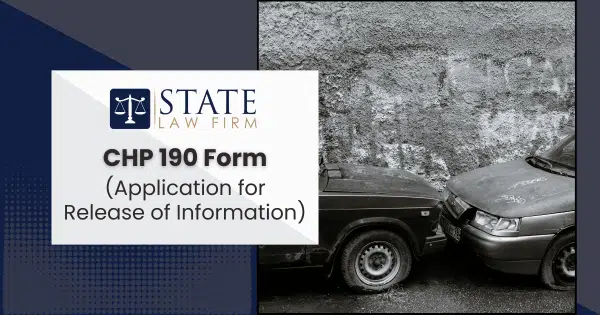If the California Highway Patrol investigated your collision, the official crash report is the record insurers and attorneys rely on to confirm facts, fault, and damages. You can obtain it either by submitting the CHP 190 “Application for Release of Information” to a CHP Area Office or by using the CHP Online Crash Report System when your report becomes available.
This guide explains who qualifies, how to choose the right request method, how to complete the form correctly, what the fees and timelines look like, and what the law allows CHP to disclose.
What the CHP 190 Form Is and Who Can Use It
The CHP 190 is a two-page request form you can submit by mail or in person at a CHP Area Office to obtain a copy of a CHP traffic collision report. The same eligibility rules also govern access through the Online Crash Report System. CHP must confirm that you are a proper “party of interest” before releasing the report, which protects the privacy of people involved while ensuring that those with a legitimate stake can access the information they need.
Parties of Interest at a glance
You are generally eligible if you fall into one of these categories and can document your status:
- Driver, passenger, pedestrian, registered owner, or owner of damaged property listed in the event
- Parent or legal guardian of a minor involved in the collision
- Legal representative of a party (attorney, guardian, or conservator)
- Insurance carrier or authorized adjuster for an involved party with a policy or claim number
- Manufacturer representative with current written authorization
- Self-insured entity or an authorized person with a signed release from a qualified party
If you are unsure whether you qualify, call any CHP Area Office and ask them to confirm your status and the best way to proceed.
Ways to Request a CHP Crash Report
CHP offers two paths: the Online Crash Report System and the CHP 190 form submitted by mail or in person. Both routes require proof that you are a party of interest. Use the comparison below to choose what fits your situation.
| Method | Steps | When to use |
| Online Crash Portal | Create an account, enter crash details, verify eligibility, and download the report once released | You want an electronic copy and your report is posted in the portal after processing |
| Mail with CHP 190 | Complete CHP 190, include a photocopy of your government ID or have the form notarized, enclose the fee, mail to the Area Office that investigated the crash | You live out of area, prefer mail, or your report is not available in the portal |
| In person at a CHP Area Office | Bring ID and fee, request at the counter, or submit a completed CHP 190 | You want help confirming eligibility, need guidance on documentation, or want to be sure the request routes to the correct office |
Online Crash Portal
Reports are typically posted after processing. Once available, you can download a PDF for your records and share it with your insurer or attorney. The portal is the fastest option when your report appears there.
Mail or in person at your CHP Area Office with CHP 190
If you submit by mail, include your payment and identification. If you lack acceptable ID, have the CHP 190 notarized. Any CHP Area Office can facilitate a report that another CHP office investigated, so you are not restricted to the office nearest the crash location.
How to Fill Out CHP 190 Correctly
Getting the form right the first time avoids rejections and back-and-forth delays. Use this checklist while you complete each field:
Step-by-step
- Collision or Incident Date. Enter the exact date. If you do not know it, provide an approximate date.
- Collision or Incident Location. Provide city, roadway, nearest cross street or mile marker. If you are unsure, add as many specifics as you can.
- Driver or Owner. List the driver or owner that ties you to the report. For property-damage-only events, list your name and address as the property owner.
- Report Number. Include it if you have it. If not, CHP can locate the report using date, time, and location.
- Party of Interest. Check only one box. Select the single role that best fits your status: involved person, family member, other party of interest, legal representative, insurer representative with policy or claim number, manufacturer representative with authorization, self-insured, or authorized person with a signed release.
- Applicant Name and Address. Print clearly and include a current phone number and email so CHP can contact you if needed.
- Agency or Company. Complete this only if you are a governmental agency, insurer, or business requesting on behalf of a party.
- Signature and Date. Sign under penalty of perjury that you are the party of interest you selected. Unsigned forms are not processed.
- Identification. Attach a photocopy of a government photo ID. If you cannot provide ID, have the form notarized to certify your identity.
- Payment. Include a check or money order payable to “California Highway Patrol.” If you know the report number, write it on the check memo line. Do not send cash by mail.
- Where to Send. Mail or deliver your packet to the CHP Area Office that investigated the crash. If you are unsure which office handled it, any Area Office can look it up and route your request.
Accuracy tips that prevent delays
- Select only one “party of interest” category. Multiple selections cause processing issues.
- Insurers should always list the policy or claim number.
- Property owners should attach proof of ownership such as a registration card, deed, or property tax record.
- Make sure names match across the form, your ID, and any authorization letter.
- Print neatly. Illegible addresses lead to returned mail.
Attachments that reduce delays
- Photocopy of your driver license or other government ID, or notarization if no ID
- Policy or claim number for insurers
- Proof of ownership for property-only requests
- Signed authorization if you act for another person
- Any CHP report or incident number you have
Cost and Processing Time
Fees. CHP charges a nominal reproduction fee that scales with report length and may differ if photos or media are requested. Typical tiers are: 1 to 25 pages, 26 to 50 pages, 51 to 75 pages, and 76 to 100 pages, with an additional charge for each additional 25 pages or portion thereof. Payment is by check or money order to California Highway Patrol. If submitting by mail, do not send cash.
Timeline. CHP indicates that traffic crash reports are typically available about eight business days after the collision, though complex investigations can take longer. Portal availability depends on processing. Mail-in requests add mailing time.
Legal Basis, Privacy, and What Can Be Disclosed
California Vehicle Code Section 20012 governs the confidentiality and release of traffic accident reports. Accident reports and supplemental materials are confidential for the use of DMV and CHP. CHP may disclose the entire contents of a report to a person with a proper interest, including drivers and passengers, parents of minor drivers, guardians or conservators, owners of vehicles or damaged property, persons who may incur civil liability, and attorneys who declare representation. A fee is permitted but may not exceed the actual cost of providing the copy.
Certain elements are expressly subject to disclosure, such as the names and addresses of persons involved or injured, witness names and addresses, vehicle descriptions and registration numbers, the date, time, and location of the accident, and insurance or suspension information. CHP may redact sensitive data for non-qualifying requesters, which is why proving party-of-interest status is essential.
Common Scenarios and Edge Cases
- Insurance company request. An insurer or authorized adjuster for an involved party can request the report. Include your business contact information and the policy or claim number that ties you to the event.
- Parent requesting a teen’s report. Parents or legal guardians of minors qualify. Include your ID and a document that connects you to the minor if CHP asks (for example, the minor’s ID or other verification).
- Property-only damage. If your fence, mailbox, building, or other property was damaged, you qualify as a party of interest. Include proof of ownership that shows you had an ownership interest on the collision date.
- Attorney for an injured passenger. Attorneys may request the report for their client by certifying that they represent a qualifying party. Include your client’s name and contact information.
- Witness listed on the report. Being a witness alone does not automatically make you a party of interest. If you believe you have a proper interest, consult counsel on the right approach or request through a qualifying party.
Exactly What to Submit and Where
Your final packet or upload should include:
- A completed CHP 190 with one “Party of Interest” box checked
- A photocopy of your government ID or a notarized CHP 190 if you have no ID
- Payment by check or money order payable to California Highway Patrol
- Policy or claim number if you are an insurer or adjuster
- Proof of ownership if your request is based on property damage only
Where to submit.
- Online: Use the CHP Online Crash Report System when your report appears there.
- By mail or in person: Submit to the CHP Area Office that investigated the collision. If you do not know which one, any Area Office can help you identify the correct jurisdiction and route your request.
Gather your documentation, choose your method, and submit your request today. If you need help after an injury or property loss, Not sure where to begin? This resource on Car accident lawyers walks you through eligibility, evidence, and recovery options.
The smoothest path is to confirm eligibility, choose the fastest channel available to you, and submit a clean, legible packet that includes identification and the correct fee. That combination prevents rejections and gets the report into your hands as quickly as CHP processing allows.


